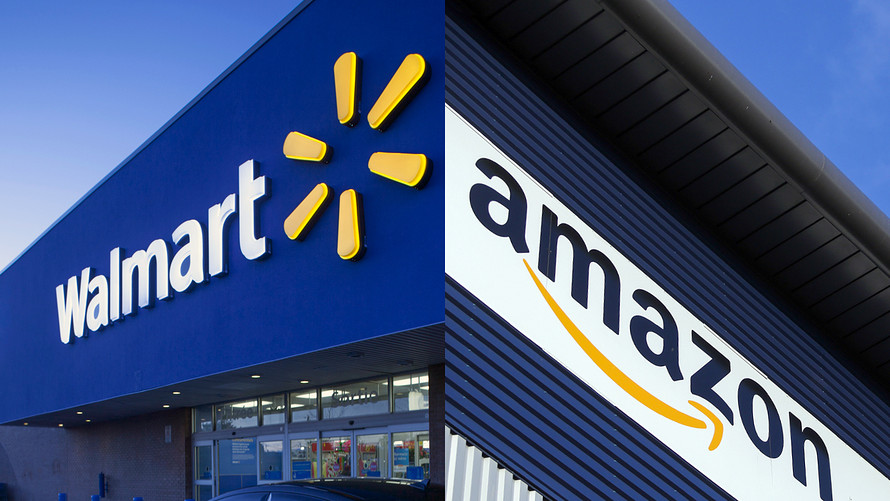
The mighty Amazon.com has been a game-changer, a disrupter, an online retail pioneer that seems to be unstoppable.
But old Wal-Mart Stores Inc. WMT, -2.16% has a few tricks up its sleeve. The Bentonville, Ark.-based company’s investments in its employees, its online offerings and delivery, and its stores are paying off in a major way. Investors in Seattle-based Amazon should pay attention.
These charts tell an interesting story. This 10-year chart shows how well shares of Amazon.com Inc. AMZN, -0.65% have performed against those of Wal-Mart:
Those six-month returns are through Nov. 15, before Wal-Mart released third-quarter results, which sent the shares up as much as 8% Thursday. Wal-Mart reported a 4.2% increase in net sales from a year earlier, with comparable sales (excluding fuel) rising 2.7% and comparable foot traffic up 1.5%. Those are impressive figures for an old brick-and-motor retailer, especially when it’s the largest one in the world, with revenue of almost half a trillion dollars last year.
Read: Wal-Mart’s stock jumps toward record high after profit and sales beat, raised outlook
Meanwhile, Wal-Mart’s online sales jumped 50% from a year earlier. And online sales accounted for 80 basis points of the company’s 2.7% increase in comparable sales. That’s a heavy effect for a business that the company had not traditionally been well-known for.
Why would you consider making an online purchase with Walmart rather than Amazon? My own experience has been that it pays to look at both sites. In one case, an item was attractively priced for $99 at Amazon, but one had to be an Amazon Prime member to purchase it. I wasn’t. Walmart.com offered the same item for the same price with free shipping.
Another personal anecdote is that, at the three local Walmart stores I’m familiar with, the company’s investment in improving its automatic checkout service means I no longer have to wait in line. Not only are there many more automatic checkout lanes, there is always at least one employee (and usually several) hovering about and helping customers through the automated process.
The numbers
Wal-Mart’s shares closed at $89.83 on Wednesday and traded for 19.4 times the consensus earning estimate of $4.64, among analysts polled by FactSet. In comparison, Amazon’s shares closed at $1,126.69 and traded for 142.1 times the consensus 2018 estimate of $7.93.
Amazon’s price-to-earnings ratios have been similarly high for years, showing that investors love the stock because of the company’s amazing long-term sales growth and its ability to disrupt one industry after another. In the third quarter, Amazon’s sales were up 34% from a year earlier, to $43.7 billion.
Can Amazon keep up this pace of sales growth for years? I don’t know. If you have a firm conviction that it can, and you are correct, Amazon should continue to be a world-beating stock. But it’s a tough act to continue.
Another interesting thing to consider is that Amazon’s market capitalization as of the close on Wednesday was $542.9 billion, or 3.4 times its $161.2 billion in sales over the past 12 reported months. Wal-Mart’s market cap was $268.3 billion, or 0.5 times its 12 months’ sales of $495 billion.
Those valuations, along with Wal-Mart’s online initiative and the improved results of its stores, make it appear to be a less risky stock than Amazon.
Return on corporate capital
Here’s another interesting way to look at the companies’ results over the long term: return on corporate capital (ROCC). It was developed by the Shareholder Forum.
A company’s ROCC is its net income plus interest expenses and income taxes, divided by the ending balance of total assets less total liabilities other than interest-bearing debt. It is similar to return on invested capital (ROIC), however, it is uniformly calculated using GAAP data from annual SEC filings. You can look up ROCC for the past five full fiscal years for individual companies here, with each company compared to its industry group.
The companies’ ROCC industry groups are the Standard Industrial Classifications (SIC) from their SEC filings. Wal-Mart’s average ROCC for the past five full fiscal years has beaten that of the “retail-variety stores” category. Amazon’s average ROCC has trailed that of the “retail catalog and mail-order houses” category, and that of Wal-Mart, by a mile.
To be sure, Gary Lutin, a former investment banker at Lutin & Co. who oversees the Shareholder Forum in New York, has said ROCC comparisons are most meaningful within industry groups and that “spending what could be booked as profits today in their development of goods and services to make bigger profits tomorrow” will be reflected in a low ROCC.
So Amazon’s approach has been worthwhile for a very long time, and its patient shareholders have been well-rewarded.
Meanwhile, Wal-Mart is making a strong case that a traditional retailer can succeed in the modern economy. And its numbers underline a less risky long-term investment play. If you still believe in Amazon, you might want to add Wal-Mart to your portfolio. If you’ve missed out on the Amazon story from your fear of its high P/E ratio, or if you believe the company cannot possibly maintain its amazing pace of sales growth over the next 10 years, Wal-Mart might be the better play for you.